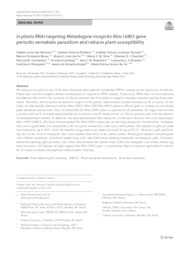In planta RNAi targeting Meloidogyne incognita Minc16803 gene perturbs nematode parasitism and reduces plant susceptibility.
In planta RNAi targeting Meloidogyne incognita Minc16803 gene perturbs nematode parasitism and reduces plant susceptibility.
Resumo: Meloidogyne incognita is one of the most important plant-parasitic nematodes (PPNs) causing severe crop losses worldwide. Plants have evolved complex defense mechanisms to respond to PPNs attacks. Conversely, PPNs have evolved infection mechanisms that involve the secretion of effector proteins into host plants to suppress immune responses and facilitate para- sitism. Therefore, effector genes are attractive targets for the genetic improvement of plant resistance to M. incognita. In this study, we functionally characterized the Minc16803 (Minc3s00746g16803) putative effector gene to evaluate its role during plant-nematode interactions. First, we found that the Minc16803 gene is expressed in all nematode life stages and encodes a protein with an N-terminal signal peptide for secretion, a motif characteristic of effector proteins and with the absence of transmembrane domain. In addition, our data demonstrated that transgenic Arabidopsis thaliana lines overexpressing a Minc16803-dsRNA efficiently downregulated the Minc16803 transcripts in infecting nematodes. Furthermore, transgenic lines were significantly less susceptible to M. incognita compared to wild-type control plants. The number of galls per plant was reduced by up to 84%, while the number of egg masses per plant decreased by up to 93.3%. Moreover, galls and feed- ing sites in the roots of transgenic lines were smaller than those in the control plants. Histological analysis revealed giant cells without cytoplasm, disordered neighboring cells, and malformed maturing nematodes in transgenic galls. Curiously, numerous hatching ppJ2 juveniles were often observed near the female body within the transgenic root tissues before egg mass extrusion. All findings strongly suggest that Minc16803 gene is a promising target to engineer agricultural crops for M. incognita resistance through host-induced gene silencing.
Ano de publicação: 2024
Tipo de publicação: Artigo de periódico
Unidade: Embrapa Semiárido
Observações
1 - Por padrão são exibidas publicações dos últimos 20 anos. Para encontrar publicações mais antigas, configure o filtro ano de publicação, colocando o ano a partir do qual você deseja encontrar publicações. O filtro está na coluna da esquerda na busca acima.
2 - Para ler algumas publicações da Embrapa (apenas as que estão em formato ePub), é necessário ter, no celular ou computador, um desses softwares gratuitos. Sistemas Android: Google Play Livros; IOS: iBooks; Windows e Linux: software Calibre.
Acesse outras publicações
Acesse a Base de Dados da Pesquisa Agropecuária (BDPA) para consultar o acervo completo das bibliotecas da Embrapa.

